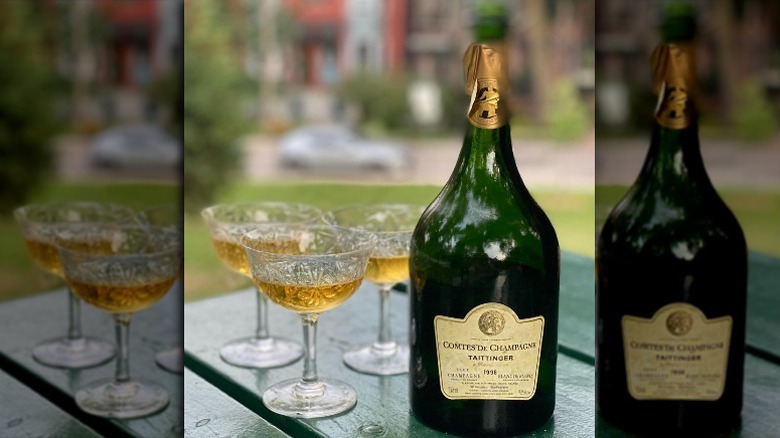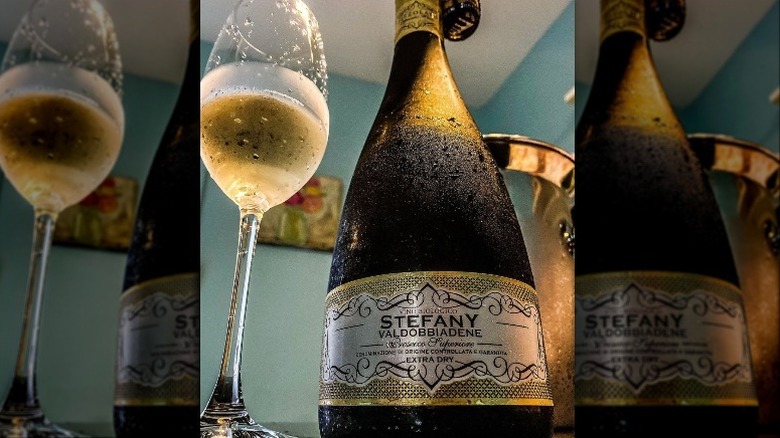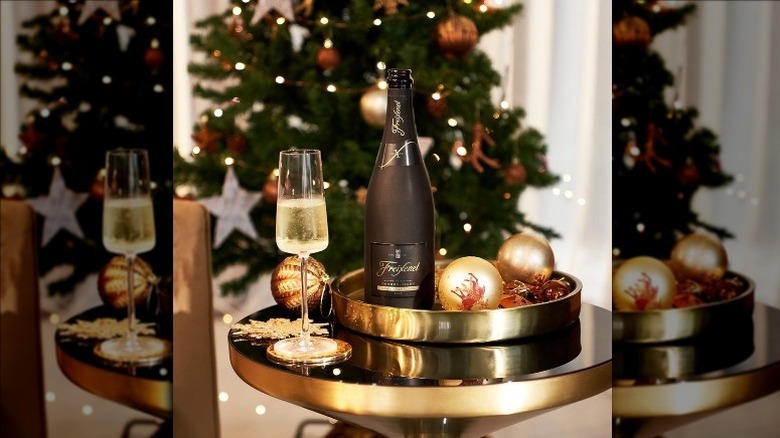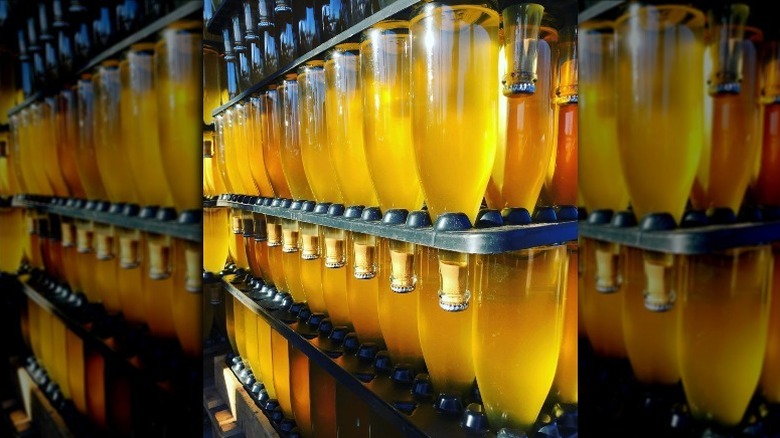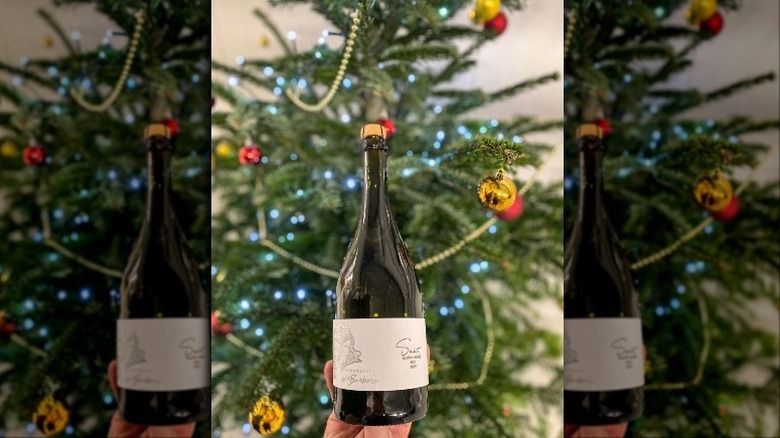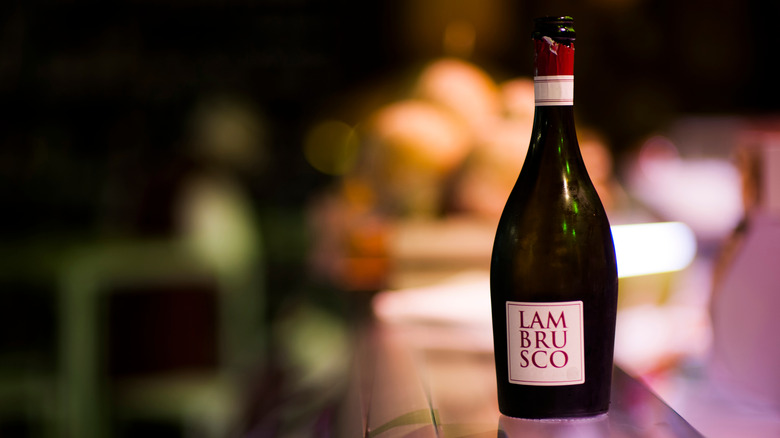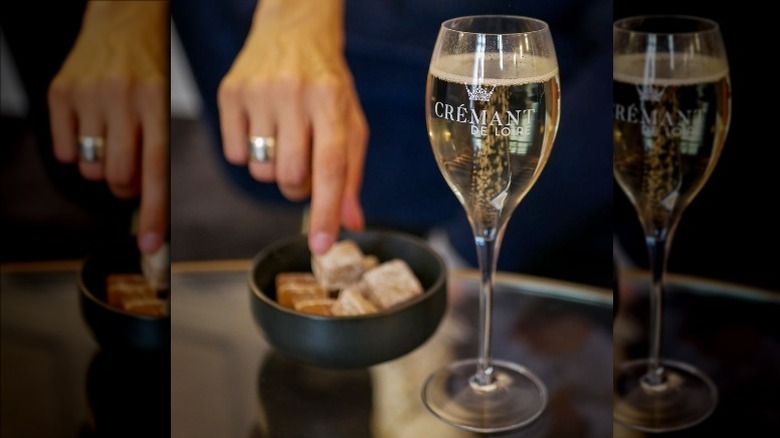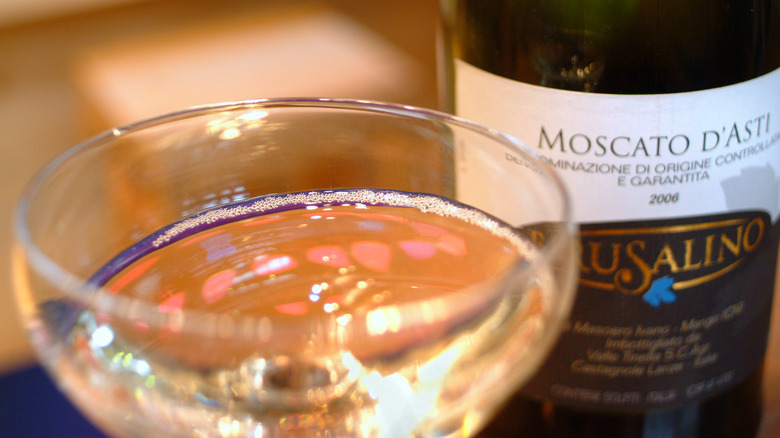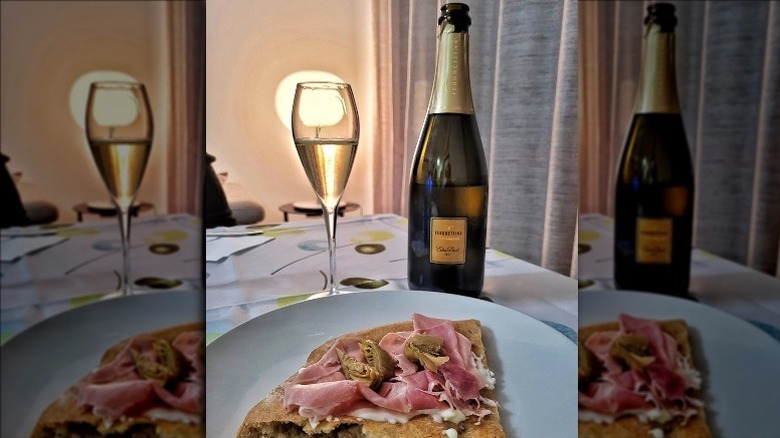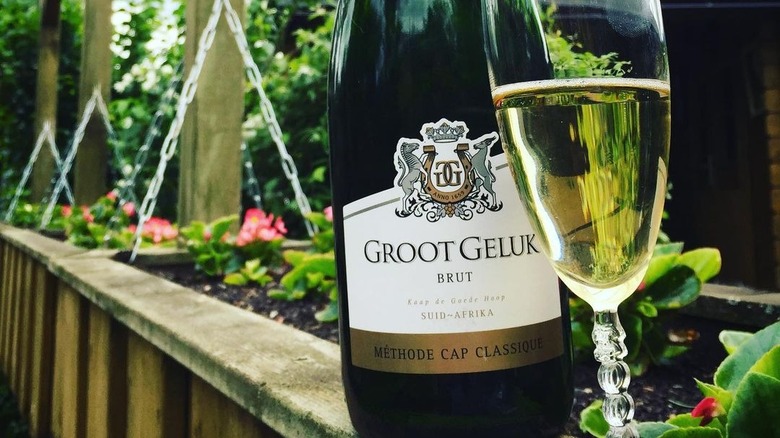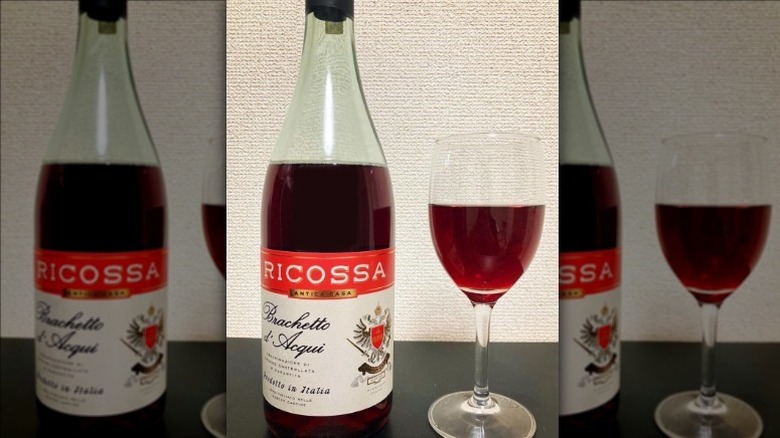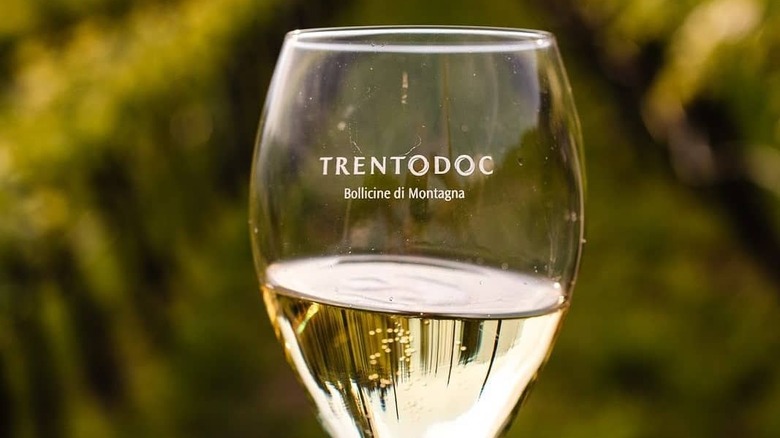13 Best Sparkling Wines For New Year's Eve
Ready to ring in the new year? You've got party hats, plenty of snacks, and your best bedazzled outfit ready to go. But you can't forget about the most important part: the bubbles. Of course, Champagne seems like the obvious sparkling wine of choice, but why limit yourself as you go into the new year? With so many amazing sparkling wines available to you, it would be a shame if you always stuck with the same thing. That's why we're here to give you the lowdown on some of the best sparkling wines to ring in the new year with. Whether you tend to prefer sweeter, juicier wines or you like to stick with the bone-dry stuff, there are plenty of sparkling wines for you to try — and you may just find a new favorite in the process.
You don't have to spend a fortune to get a good bottle of wine, but it does help to know what you're looking for before you make your way to your local wine shop. Ask for any of these wines, and you know you'll be getting a fun, festive glass of bubbly. But remember: You don't have to limit sparkling wines to New Year's Eve! They're enjoyable all year long.
1. Champagne
Let's get the most obvious choice out of the way. When you think of a celebratory drink, Champagne probably comes to mind. Typically made with chardonnay, pinot noir, and pinot meunier grapes, it's high in acidity, which means when you take a sip, it'll make your mouth water. A lot of Champagnes have citrusy notes to them, but you may also notice flavors of almond, cream, or even toast.
The best Champagne has been aged for three years or more, so you may be paying a bit more for a good bottle of Champagne than you would spend on other sparkling wines. But if it's for a special occasion, we think splurging every once in a while is okay.
Planning on pairing your Champagne with snacks or even a whole dinner? Bubbly, acidic wines generally taste best when paired with salty, fatty foods — perfect if you're staying up late and imbibing. You can keep it classy with some heavy hors d'oeuvres or olives, but we like to mix it up and go with something a little more whimsical. Potato chips or canned sardines could make a fun addition to your spread if you're serving Champagne.
2. Prosecco
Prosecco is another common sparkling wine you'll find in your grocery store wine aisle and at the nice wine shops alike. Prosecco wine is usually produced in Northeast Italy, in a region called Veneto. However, it is now being produced in Slovenia as well as Australia, so be on the lookout for these far-flung varieties. Prosecco is different from Champagne — it tends to be slightly sweeter and it's also usually less acidic, though this varies from wine to wine. These differences come from the type of grapes used but also from the fermentation process.
If you're looking for a solid Prosecco that won't set you back too much money, we recommend Prosecco Masottina Brut. A brut sparkling wine is going to be on the drier side, so if you don't like too much sweetness in your wine, it's a great option. Even if you can't find this Prosecco specifically, you shouldn't have a hard time locating an affordable bottle of the stuff to share with friends and family on New Year's Eve.
3. Cava
We've covered the most-recognized sparkling wines of France and Italy ... what about Spain? That's where Cava comes in. If you like Champagne and Prosecco, there's a good chance that you'll like this stuff too. Acidic and generally relatively dry, you probably won't find any vintages, or years, on a bottle of Cava. That's because, per MasterClass, most Cava doesn't have a vintage. Instead, it's made from a blend of different vintages.
Cava tends to be more similar to Champagne because they are both made using the same methods. However, you can get a good bottle of Cava for less than you would pay for a superior Champagne. Wondering how much you should drop? According to Wine Enthusiast, good Cava can be enjoyed for under $30. One solid sub-$10 option is Freixenet's Cordon Negro Brut Cava, which is zesty, fresh, and perfect for ringing in the new year. Pair it with Spanish tapas if you want to stay on theme, or opt for some oysters if you're trying to go all-out in your celebrations.
4. Pét-nat
If you've stepped foot into a trendy wine bar in the last few years, you've probably noticed a pét-nat on the menu. It's short for Pétillant Naturel, which essentially means "naturally sparkling." Pét-nats are super popular these days, but many wine drinkers are unsure of how they're different from other sparkling wines. It all comes down to how they're fermented. Most sparkling wines are fermented twice, and the second fermentation produces the bubbles. However, pét-nats are just fermented once, and that initial fermentation process produces the fizziness you know and love. This process of making sparkling wine is known as "methode ancestral," and experts believe it's how sparkling wines were originally created.
Wondering what pét-nat you should go for? Chances are, you're not going to find a bottle of this stuff at your nearest big box grocery store. Rather, we'd suggest that you visit a local wine shop and ask about local or small-scale wineries that produce interesting pét-nats. The people who work there should be able to point you in the direction of a fun, festive wine that will wow your guests. As for us? Iapetus Figure 2 is one of our faves.
5. Sekt
Sparkling wine from Spain, Italy, and France may be common, but one country that is often left out of the conversation is Germany. However, Germany boasts a special contribution to the world of sparkling wine, and that contribution is known as Sekt. According to Wine Enthusiast, Germans drink more sparkling wine than any other population in the world. However, most of the Sekt that the country produces stays within its borders. So, unless you've spent time in Germany and enjoyed the wine there, you may have never tried this variety before.
Though it was once exclusively a cheap, mass-produced wine, similar in quality to Prosecco, smaller vineyards are now trying to craft top-tier Sekt. There are still plenty of affordable Sekts on the market, though, so don't worry if you're trying to stick to a budget. You may have a difficult time finding Sekt outside of Germany, but you can always contact your local wine shop and check to see if they have any bottles on hand. At the very least, it's a great excuse to plan a trip to Germany!
6. Lambrusco
Looking for something a little different for New Year's Eve? Something that will pair well with just about anything you have on the menu for the night? If so, it's time to pick up a Lambrusco. Lambrusco is one of the oldest styles of Italian wine. This one is a little different than most of the others on this list because it's actually a sparkling red. If that doesn't make you feel festive, we don't know what does. You might detect notes of strawberry, blackberry, and rhubarb. And the best part? You can get a good Lambrusco without spending much money — you should expect to dole out about $10.
Wine Enthusiast suggests a few Lambruscos that you may want to swill on New Year's Eve. The Fiorini 2020 Corte degli Attimi (Lambrusco di Sorbara) is a great value and offers notes of red berries, violet, and bread dough. Cantina Settecani di Castelvetro NV Vini del Re (Lambrusco di Modena) is also a top budget-friendly option.
7. Crémant
Crémants generally come from France, but their color can differ drastically from one bottle to the next — you can find both white and rosé varieties. This type of wine is a fantastic choice if you want Champagne but don't want to pay the Champagne price tag. That's because these wines are made with the same method used for Champagne. Therefore, you're going to get a more budget-friendly bubbly that still has many of the same characteristics as your favorite expensive bottle. The regulations for what can be considered a Crémant are slightly less rigorous than those of Champagne, but not by much.
There are quite a few different varieties of this type of wine, all made with different grapes, so it can be fun to taste what makes them different. Gustave Lorentz, Zéro Dosage, Crémant d'Alsace, 2017 works if you're looking for a wine that will offer great taste and value. We think it's a great option for popping open while the ball drops.
8. Moscato d'Asti
Calling all sweet wine lovers: Moscato d'Asti may just be your new go-to bottle. However, even for those who don't really love a sweet wine, this may still be a solid option. These wines are lightly carbonated, or frizzante, and those bubbles make the wine taste less sweet than it really is. Therefore, you can more easily pick up on the acidity, which adds a nice zing of refreshment to every sip. You may notice notes of lemon, mandarin orange, and pear, which gives this wine a celebratory feel that's perfect for New Year's Eve.
The Saracco 2019 Moscato d'Asti is a top choice that boasts of the wine's sweetness, juiciness, and depth. But what we love most about Moscato d'Asti is that it's a super easy sparkling wine to find on the shelves of your local wine shop. Check out your options, or ask someone who works there to guide you in the right direction.
9. Vinho Espumante
As you can already tell, plenty of European countries produce sparkling wine, and Portugal is no exception. Enter Vinho Espumante. This wine is similar to the sparkling wines you'll find in other parts of the continent, but they can be harder to find ... even for the Portuguese! According to We Travel Portugal, less than 1% of domestic wine sales in the country come from Vinho Espumante. Therefore, it could be difficult to find at your local wine shop as well. However, if you know a spot that has a great Portuguese selection, you might just find what you're looking for.
There are bottle-fermented varieties of Vinho Espumante, which are created in the same way that Champagne is made. These are going to be your highest-quality wines, but they're also going to cost more than other types. Some Vinho Espumantes are carbonated in a tank, while still others are pumped with CO2 (you'll want to avoid these if possible). As another fizzy, light wine, Vinho Espumantes of all varieties make for an ideal celebration drink.
10. Franciacorta
Here's another Italian wine for you: Franciacorta. It may be less popular than Prosecco, but that doesn't mean you shouldn't give it a chance. It comes from the Lombardy region of the country. In this area, they make wine with the same grapes as Champagne, but with one difference: they add pinot blanc, per Wine Folly. The result is a tart, acidic wine with a touch of sweetness for those who don't like their drinks too dry. If you're going to spring for a Franciacorta, expect to pay a bit more than you would for some of the other wines on this list: Wine Folly notes that you can find a bottle for about $40.
If you don't like your wine too sweet, this may not be a great option for opening as the ball drops, but we do think that it pairs well with plenty of foods. Maybe start with some snacks? Wine Folly suggests pairing this wine with soft cheeses (think brie), salted nuts, and dried fruit. Who doesn't like sipping on some sweet wine while they snack?
11. Méthode Cap Classique
If you love Champagne but you're not a big fan of the price point, you may want to check out other traditional method sparkling wines. Méthode cap classique wines hail from South Africa, and they're made in the same way Champagne is made in France. Basically, this means that the wine goes through two separate fermentations. The second fermentation is what creates the bubbles, and this process is done in the bottle, as opposed to a tank or another type of vessel. This process results in a toasty, brioche-like flavor that traditional method wines are known for. Generally, méthode cap classique wines are made with some combination of pinot noir, chardonnay, and meunier grapes, which happen to be the most-used grapes in Champagne as well.
You can enjoy méthode cap classique wines with whatever you'd normally eat Champagne with. Oysters and caviar are classics, for example, but we also love traditional method sparkling wines with breakfast. If you don't finish the bottle on New Year's Eve, you can always enjoy the leftovers with some eggs, bacon, and pancakes the next morning.
12. Brachetto d'Acqui
Prefer just a hint of fizz? Tend to like red wines over white? You might want to get your hands on some Brachetto d'Acqui, a frizzante, or semi-sparkling, wine from the Piedmont region of Italy. The region may be most famous for its Barolo and Barbaresco, but Brachetto d'Acqui offers a lighter, more easily chuggable sparkling wine, which is ideal for the holiday season when you want to pour your friends and family something fizzy.
This wine tends to be on the sweeter side, so if you usually go for the dry stuff, it might not be right for you. However, relatively high acidity still keeps things feeling fresh and easy to drink, so you can probably drink a couple of glasses of the stuff without getting a terrible headache.
Wondering what to pair your Brachetto with? Since it's sweet, it's a good candidate for a dessert wine, so you can pair it with any of the sweet treats you have lined up for the night. It's also lovely for pairing with fruit, nuts, and cheeses — basically anything you can snack on while you wait for the ball to drop.
13. Trentodoc
Another traditional method sparkler you have to try is Trentodoc, which comes from Trentino in the north of Italy. Sure, Prosecco may have more name recognition, but if you're looking for the toastiness of Champagne instead of a lighter, fruitier wine, then you should opt for Trentodoc instead. It often has notes of dough and almonds, which results in a fuller-bodied mouthfeel and a richer texture that feels indulgent. These wines, like many traditional method sparkling wines, are generally made with pinot noir and chardonnay.
If you want to taste some particularly good examples of Trentodoc on the market, you may want to look for the term "Riserva" on the label. In the case of Trentodoc, this means that the wine has aged on the lees for at least three years. The longer the wine sits on the lees, the more of that bready, toasty flavor you'll be able to pick up in the glass.

